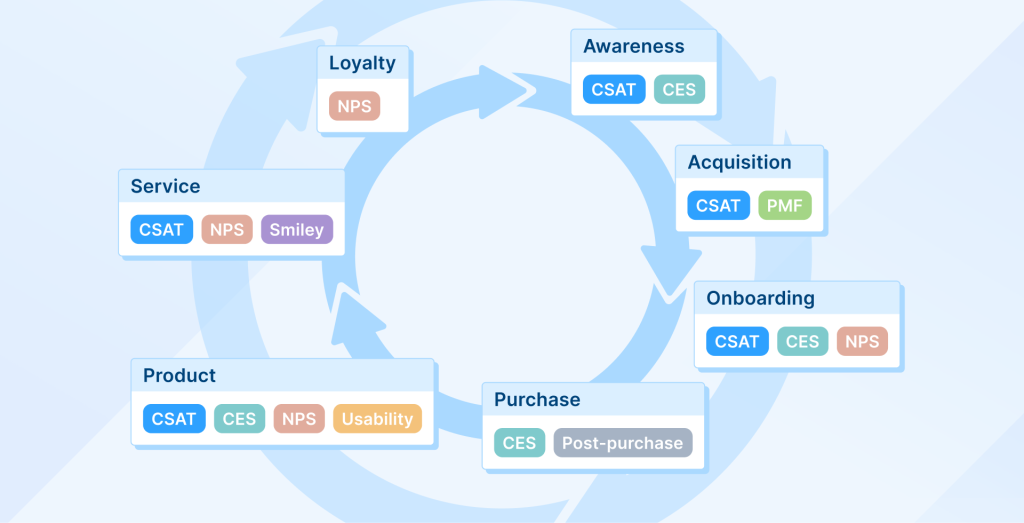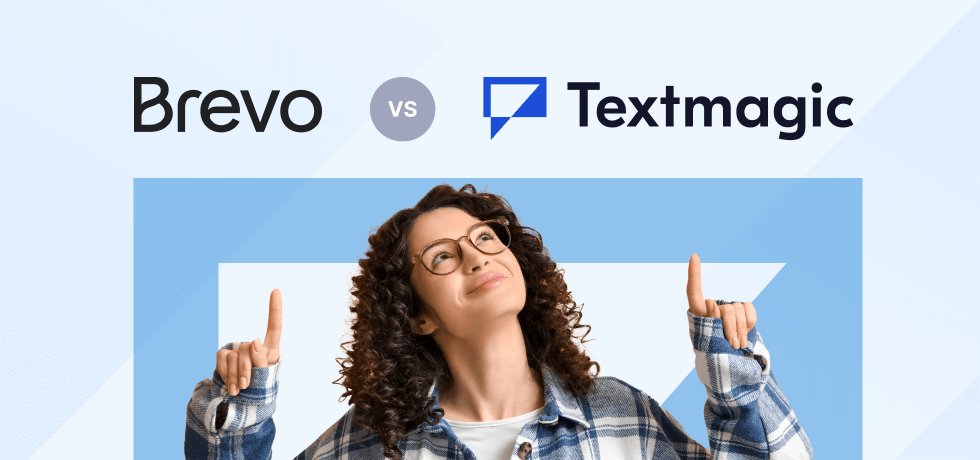
Knowing what customer satisfaction survey questions to ask to get the most valuable feedback possible can be difficult.
In this article, we will list different types of survey questions you can use to gather valuable insights based on the stage of your customer’s journey.
Whether you are just starting or have an established business, understanding how to ask the right questions can help improve your customer experience and grow your business.
How to use these questions in your surveys
We organized the survey questions according to the typical customer journey stage within a SaaS company:
Awareness > Acquisition > Onboarding > Purchase > Product use > Service > Loyalty
This allowed us to include more examples that might be relevant to your use case. Please note that the customer journey will vary according to your industry and business type.
We strongly encourage you to map out each journey stage to achieve clarity and alignment within your team. Here are some typical journey steps that are common for different businesses (e-commerce, small business, etc.):
Awareness > Consideration > Acquisition/Purchase > Service > Loyalty
We also recommend survey types for each group of questions and journey stage. Check our article on customer survey types for quick templates.

Lastly, this list prioritizes open-ended questions because they make it easier for customers to share their thoughts in their own words. Closed-ended questions generally lead to extreme response and survey bias.
Here are the main types of customer satisfaction survey questions you should be asking:
1. Questions to assess brand perception and awareness

These questions focus on how the customer sees your brand, what they associate with it, and how compatible their values are with the ones your product is based on.
- “What is your overall impression of our brand?”
- “What words would you use to describe our brand?”
- “What comes to mind when you think of our brand?”
- “How does our brand compare to our competitors?”
- “How likely are you to purchase from our brand again?”
- “How would you rate the quality of our [website section]?”
- “How would you rate the customer service provided by our brand?”
- “How would you describe the values and personality of our brand?”
- “How well does our brand align with your values and needs?”
- “How well-known is our brand in your industry or market?”
- “How likely are you to recommend our brand to others?”
- “How satisfied are you with the content/information on this website?”
- “Did you find the information you were looking for?”
- “Did we make it easy for you to find the information you were searching for?”
- “How would you rate the clarity of this page?”
✅ Recommended in: CSAT and CES surveys.
Here’s how you can word the question related to website clarity for CSAT and CES:
CSAT: How satisfied are you with the clarity of the website?
Answer scale: 1 (very dissatisfied) to 5 (very satisfied).
CES: The website made it easy for me to find the information I was looking for.
Answer scale: 1 (strongly disagree) to 5 (strongly agree).
Depending on the answer, you should follow-up with an open ended question and allow your customers to elaborate.
2. Questions to ask during the acquisition process

These customer satisfaction survey questions focus on the customer’s overall opinion of your product or service.
- “How satisfied are you with our product/service?”
- “What did you like most about our product/service?”
- “What did you dislike about our product/service?”
- “Was our product/service easy to use?”
- “Did our product/service meet your expectations?”
- “Would you recommend our product/service to others?”
- “How would you rate the overall quality of our product/service?”
- “Did our product/service meet your needs?”
- “What improvements would you suggest for our product/service?”
- “Would you say that our product/service was good value for money?”
- “Would you purchase our product/service again?”
✅ Recommended in CSAT and PMF (product-market fit) surveys.
3. Questions to ask during the onboarding process

These are questions used by SaaS companies during the early stages of client onboarding and work very well in CSAT, CES, and NPS surveys.
Please note that NPS surveys should always start with a scale-rating question, like “On a scale from 1 to 10, how likely are you to recommend [product/service] to your friends or colleagues?” before you can follow up with open-ended questions. Keep this in mind every time you see NPS as a recommended survey for the sample questions we share.
- “What motivated you to seek out our product/service?”
- “What integrations would be useful for your organization?”
- “Have you used similar products/services in the past? If so, which ones?”
- “Are there any specific metrics you’d like to see in our reporting or analytics?”
- “What level of automation do you envision for our product/service?”
- “How would you like to receive updates about our product/service?”
- “What kind of support/training do you need to fully utilize our product/service?”
✅ Recommended in: CSAT, NPS, CES surveys.
4. Questions to determine the purchase experience

These questions focus on the overall customer experience during the purchase process.
- “Did the checkout process run smoothly?”
- “Did you receive your order on time?”
- “Was the purchasing experience easy and straightforward?”
- “Were you able to find the products/services you were looking for?”
- “Do you consider the prices to be fair and reasonable?”
✅ Recommended in: CES and post-purchase surveys.
5. Questions to determine product usability

These questions focus on the customer’s experience with the company’s website or mobile app.
- “Was the website/app easy to navigate?”
- “Did you experience technical difficulties using our website/app?”
- “Were you able to find what you were looking for?”
- “Were the website/app layout and design easy to use and visually appealing?”
- “Was the website/app easy to use on different devices (e.g., desktop, mobile, tablet)?”
- “Did you encounter any errors or glitches while using the website/app?”
- “Was the website/app loading speed satisfactory?”
- “Was it clear what actions you needed to take to accomplish your goal on the website/app?”
- “Did you find the website/app to be user-friendly?”
- “How likely are you to recommend the website/app to others?”
✅ Recommended in: CSAT, CES, NPS, product usability surveys. If you are using these questions in NPS surveys, always start with the typical scale-rating question, then follow up with the examples above.
6. Customer service satisfaction questions

These customer satisfaction survey questions focus on the customer’s experience with support representatives.
- “How helpful was the customer service representative?”
- “Were your questions or concerns resolved to your satisfaction?”
- “How satisfied are you with the service you received?”
- “Was our customer service team helpful in resolving your issue?”
- “Did you find our customer service representative(s) friendly and courteous?”
- “Was your issue resolved in a timely manner?”
- “Did you experience clear communication throughout your interaction with our agent(s)?”
- “Did our customer service team meet your expectations?”
- “Was our customer service team up to date with the products/services?”
- “Were you satisfied with the outcome of your interaction with our customer service team?”
- “Did our customer service team follow up with you after resolving the issue?”
- “How likely are you to recommend our customer service to others?”
✅ Recommended in these surveys: CSAT, NPS, smiley surveys. When using rating scales, make sure to also follow-up with an open-ended question like “Can you share more details about your experience?”
7. Questions for feedback and suggestions (loyalty stage)

These questions focus on the customer’s ideas for improvement and determine their potential loyalty to your brand.
- “How do you think we could improve our product/service?”
- “What other products/services would you like to see us offer?”
- “How can we make our customer experience better for you?”
- “What can we do to provide better value to our customers?”
- “Are there any features or functionalities you feel are missing from our products/services?”
- “What can we do to make our products/services more user-friendly?”
- “How can we better meet your needs as a customer?”
- “What areas do you think we could improve our customer service?”
- “What could we do to differentiate ourselves from our competitors more?”
- “How can we better communicate with you about our products/services?”
- “Is there anything we can do to make our pricing more accessible for you?”
✅ Recommended in: NPS surveys.
Mistakes to avoid in your survey questions
While asking customers for feedback can provide valuable insights, there are some common mistakes that businesses can make when creating their feedback questions:
- Asking vague questions
When you ask open-ended questions that are too broad or general, you may not get the specific feedback you need. Instead, try asking targeted questions focusing on specific product or service aspects.
- Using leading questions
Leading questions can make customers lean towards a particular answer. For example, asking, “Don’t you just think our product is great?” implies that the product is close to perfection and may lead to positive feedback regardless of the customer’s true opinion. Instead, ask neutral questions that allow customers to provide their honest opinions.
- Not offering enough response options
When you offer limited response options, you may miss out on valuable feedback. Ensure that you provide various response options covering the full spectrum of possible feedback.
- Asking too many questions
When you start asking too many questions, customers may become frustrated or lose interest in providing feedback. Keep it concise and relevant to ensure that customers remain engaged.
Best practices for asking customer satisfaction survey questions
Here are some best practices to consider when creating your customer feedback questions:
- Before creating your feedback questions, define your specific goals and what insights you hope to gain from the feedback. This will help you create targeted questions that provide the information you need.
- Make sure your questions are clear and easy to understand. Use simple language and avoid technical terms or industry jargon that customers may not be familiar with.
- Different question types can provide different types of feedback. Mix open-ended, multiple choice, or rating scale questions to gather qualitative and quantitative feedback.
- Make sure your questions focus on the customer experience and the factors that are important to them. Ask questions about their overall satisfaction, ease of use, and any pain points they may have encountered.
- Before sending out your feedback survey, test your questions with a small group of customers to ensure they are clear and effective. This can help you identify any issues and make adjustments before sending the survey to your full customer base.
How to easily gather customer feedback with surveys
Tap into social media
Social listening is a valuable source of the voice of customer data and honest feedback. Many networks now feature built-in polling tools that make the feedback submission process effort-free. Combined with direct comments or mentions, these strategies create natural engagement and ensure your survey reaches its desired audience.
Monitor on-site activity
Leveraging analytics is your best option to fully understand how users interact with your company. This goes especially well for digital products because numbers and stats offer precious insight into how you can improve your product. You can tweak your messaging to avoid bounce rates or access data on failed searches, frequently visited pages or anything that leads to improving the customer experience.
Take advantage of user testing tools
User testing involves observing customers using your product or service and getting feedback on their experience. You can use tools like UserTesting or Hotjar to research user behavior and share relevant satisfaction questions at the right time.
Conclusion
According to a recent study, 88% of customers say that a company’s experience is as important as its products and services. As consumer preferences evolve rapidly, prioritizing customer feedback is more important than ever.
By asking the right questions, you can gain valuable insights into what your customers want and need, identify areas for improvement, and build better relationships with them.
When you listen to your customers and take action on their feedback, you grow your business and stay ahead of the competition.
Frequently Asked Questions (FAQs)
The four main types are open-ended, closed-ended, rating scale, and multiple-choice. Each serves a different purpose, from gathering opinions to measuring satisfaction numerically.
It’s a rating scale question that asks customers to evaluate their experience or satisfaction on a scale from 1 (poor) to 10 (excellent). It’s commonly used to gauge overall sentiment or loyalty.
Use a direct question like “How satisfied are you with our service?” followed by a scale or multiple-choice options. You can also ask, “Did our service meet your expectations?”
With Textmagic, you can send these questions as an SMS survey to your audience to collect feedback quickly and conveniently.
Customer satisfaction can be measured through surveys, reviews, Net Promoter Score (NPS), and follow-up feedback. Regular monitoring helps you track trends and detect issues early.
It depends on your goal. A strong all-purpose question is “How likely are you to recommend us to a friend or colleague?” as it reveals both satisfaction and loyalty.
Related articles
How to calculate customer health score and slash churn rates
Customer health scores are metrics that reduce custo...
Brevo vs. Textmagic: Features and pricing comparison guide
Running a marketing campaign is the first step towar...
How to craft the perfect Thanksgiving text message
Thanksgiving is significant as a time for gratitude ...
Geofencing vs geotargeting: Which is the best for your business
Location-based marketing strategies such as geofenci...
Business texting etiquette: 14 rules for your SMS campaign
Whether you’re reaching out to customers, part...




